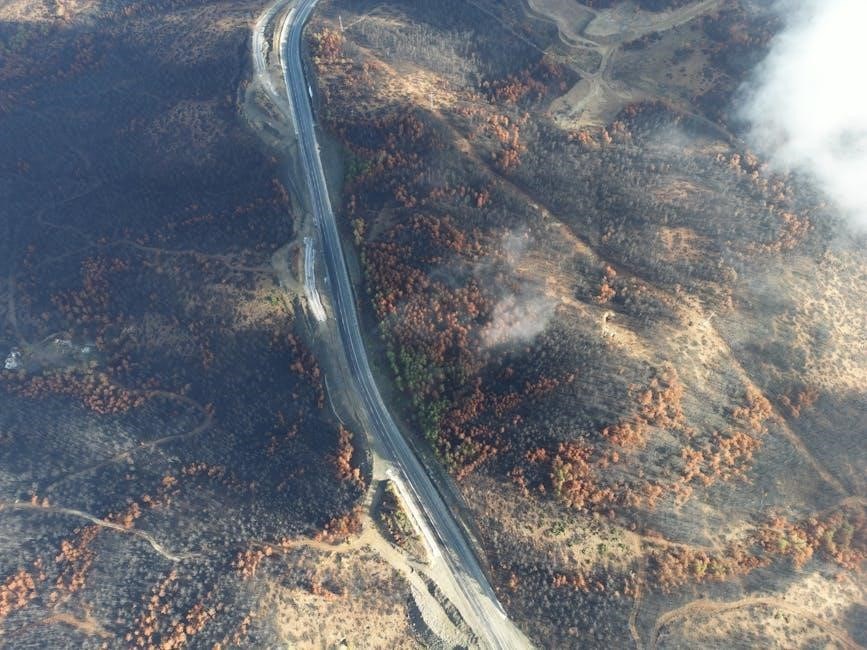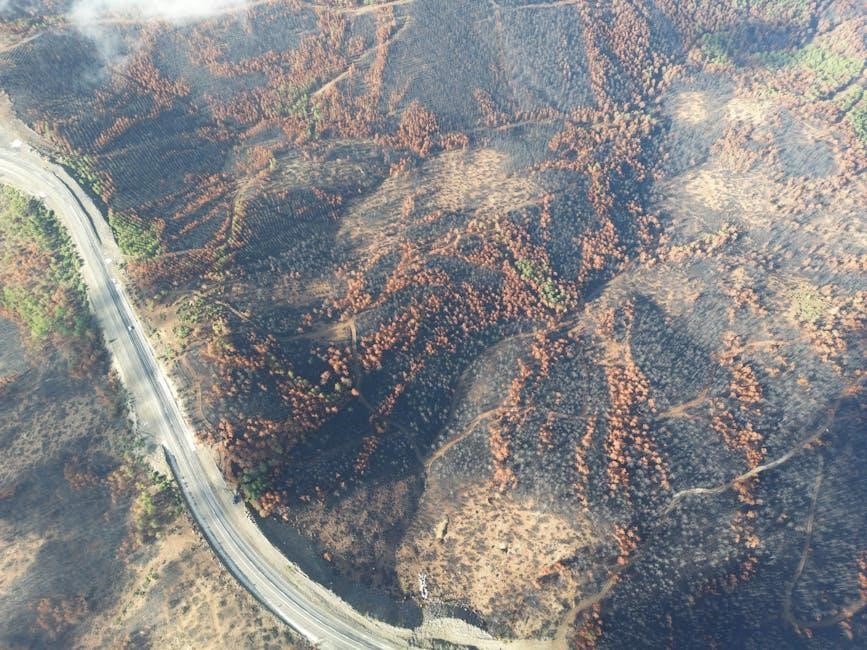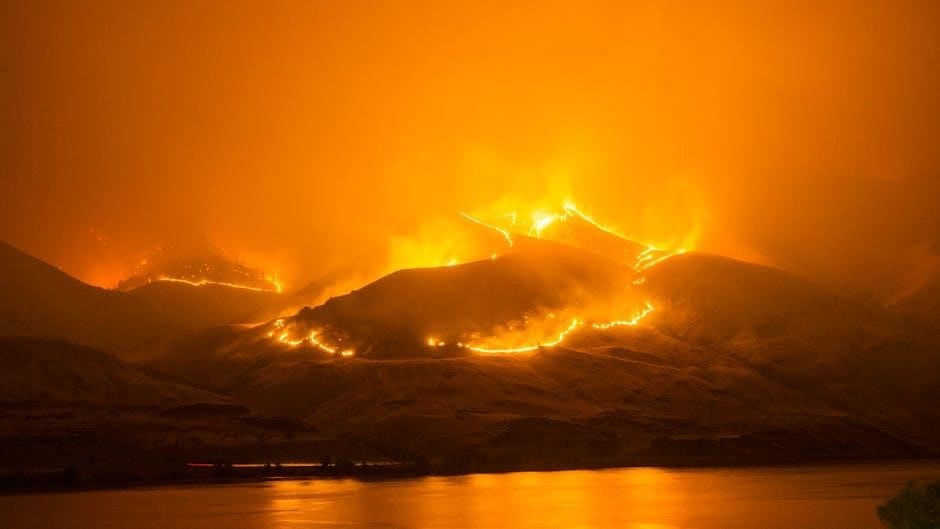Welcome to the Wildfire Extension Tutorial, your guide to understanding and utilizing tools for tracking and managing wildfires effectively. This tutorial will help you navigate the features, installation, and customization of wildfire tracking extensions, ensuring you stay informed and proactive in wildfire situations.

1.1 Overview of Wildfire Extension
The Wildfire Extension is a powerful tool designed to help users track and manage wildfires effectively. It integrates with NASA’s Open API and Google Maps API to provide real-time data and visual representations of wildfire locations and spread. This extension is particularly useful for residents, firefighters, and agricultural producers in fire-prone areas. It offers customizable alerts, predictive analytics, and GIS mapping to enhance preparedness and response. Additionally, the extension supports educational resources from institutions like Oregon State University and the University of Wyoming, ensuring users have access to training and support. By leveraging advanced APIs and user-friendly features, the Wildfire Extension serves as a comprehensive solution for wildfire monitoring and management.
1.2 Importance of Wildfire Tracking and Management
Wildfire tracking and management are critical for protecting lives, property, and ecosystems. With over 25,000 wildfires burning 1.3 million acres in the U.S. annually, the need for real-time monitoring is urgent. Tools like the Wildfire Extension enable users to stay informed about fire locations, spread, and severity, allowing for timely evacuations and resource allocation. Early detection and monitoring can prevent small fires from escalating, reducing environmental damage and economic losses. Additionally, tracking helps firefighters strategize containment efforts effectively. For agricultural producers and rural residents, especially in fire-prone areas like Nevada and Laguna, this information is vital for safeguarding livestock and crops. The Wildfire Extension plays a key role in providing accessible, actionable data for communities at risk.

Installation and Setup of Wildfire Extension
Installing the Wildfire Extension is straightforward, requiring minimal development work. Users can enable it via Chrome settings by navigating to Manage Extensions and turning it on. The extension integrates seamlessly with APIs like NASA and Google Maps for enhanced functionality, ensuring real-time wildfire tracking and visual representation.
2.1 Step-by-Step Installation Guide
To install the Wildfire Extension, start by accessing the Chrome Web Store. Search for the extension and click Add to Chrome. Once added, navigate to Manage Extensions in Chrome settings to enable it. Ensure the extension is turned on, as Chrome may disable it automatically. After enabling, configure the extension by integrating NASA Open API and Google Maps API for real-time data and visual mapping. Follow the prompts to authorize API access and customize settings for optimal performance. The extension is compatible with most browsers, allowing seamless wildfire tracking across devices. This setup ensures you receive timely alerts and accurate wildfire information, enhancing your ability to monitor and respond to fire events effectively.
2.2 Configuring the Extension for Optimal Use
After installation, configure the Wildfire Extension to suit your needs. Enable real-time wildfire tracking by integrating NASA Open API for accurate fire data and Google Maps API for visual representation. Customize alerts by setting specific locations and severity levels to receive notifications. Adjust notification preferences to avoid overwhelming alerts. Ensure the extension is compatible with your browser by enabling it in the Manage Extensions section. Regularly update the extension to access the latest features and improvements. By tailoring these settings, you can maximize the extension’s functionality and stay informed about wildfire activity in your area or regions of interest. Proper configuration ensures a seamless and effective user experience.
Key Features of Wildfire Extension
The Wildfire Extension offers real-time wildfire tracking, customizable alerts, and integration with NASA and Google Maps APIs for precise data and visual representation, enhancing user awareness and preparedness.
3.1 Real-Time Wildfire Tracking

The Wildfire Extension provides real-time tracking of wildfires, enabling users to monitor active fires globally. By integrating with NASA’s Open API, the extension delivers up-to-date data on fire locations, sizes, and spread. This feature is particularly useful for residents in fire-prone areas, allowing them to stay informed and take proactive measures. The extension also utilizes Google Maps API for visual representation, making it easier to assess fire proximity to specific locations. With real-time updates, users can track multiple fires simultaneously, receiving critical information as events unfold. This tool is essential for anyone needing to stay ahead of wildfire activity, ensuring safety and preparedness. The real-time tracking feature is a cornerstone of the Wildfire Extension’s functionality, providing actionable insights during emergencies.
3.2 Customizable Alerts and Notifications
The Wildfire Extension offers customizable alerts and notifications, allowing users to stay informed about fire activity relevant to their specific needs. Users can set up alerts based on location, fire severity, and other criteria, ensuring they receive timely updates. The extension integrates with NASA’s Open API and Google Maps API to provide accurate and real-time data. For instance, users in Nevada or Douglas County can receive alerts tailored to their region, helping them take immediate action. Customizable notifications enhance situational awareness, enabling users to protect their properties and communities effectively. This feature is particularly valuable for those in high-risk areas, providing peace of mind and critical information during emergencies. By personalizing alerts, the Wildfire Extension empowers users to respond proactively to wildfire threats.

Using Wildfire APIs for Enhanced Functionality
Enhance your Wildfire Extension with APIs for advanced features. Integrate NASA’s Open API for real-time wildfire data and Google Maps API for visual representation. Visit GitHub for the project.
4.1 Integrating NASA Open API for Wildfire Data
Integrating the NASA Open API into your Wildfire Extension enables access to real-time wildfire data, enhancing tracking and management capabilities. This API provides accurate and up-to-date information on active fires, including location, size, and intensity. By leveraging NASA’s resources, you can overlay this data on maps for a comprehensive visual representation. The integration process involves registering for an API key and configuring the endpoint URLs. Once set up, the extension can fetch and display wildfire data dynamically. This feature is particularly useful for researchers, emergency responders, and the general public seeking reliable wildfire information. Visit the NASA Open API documentation and the GitHub project for detailed implementation guidance.
4.2 Leveraging Google Maps API for Visual Representation
Leveraging the Google Maps API enhances the visual representation of wildfire data, providing an interactive and intuitive way to track fires. By integrating this API, you can plot wildfire locations, sizes, and movement on a dynamic map. The API allows for features like markers, polygons, and overlays, making it easier to visualize affected areas. This integration is particularly useful for understanding the spatial distribution of wildfires and their proximity to critical locations. The Google Maps API also supports real-time updates, enabling users to monitor fire spread and respond accordingly. For a detailed implementation, refer to the Google Maps API documentation and explore the wildfire tracker map project on GitHub for practical examples.
Customizing the Wildfire Extension
Customize the extension to meet specific needs by tailoring settings, integrating APIs, and creating custom workflows for enhanced functionality and personalized wildfire tracking experiences.
5.1 Tailoring the Extension to Meet Specific Needs
The Wildfire Extension allows users to tailor its functionality to suit their specific requirements. By adjusting settings, users can customize alerts, map views, and data sources to focus on areas of interest. Integration with APIs like NASA Open Data and Google Maps enables enhanced visualization and real-time updates. Additionally, the extension supports custom automation workflows, allowing users to create personalized alerts and notifications based on predefined conditions. This flexibility ensures that the tool can be adapted for various use cases, from monitoring local wildfires to supporting large-scale fire management efforts. By leveraging these customization options, users can maximize the extension’s effectiveness in addressing their unique needs and challenges.
5.2 Creating Custom Automation Workflows
Custom automation workflows in the Wildfire Extension enable users to streamline tasks and responses. By leveraging tools like NASA Open API and Google Maps API, users can automate data retrieval and mapping processes. For instance, workflows can be set up to trigger alerts when wildfires approach specific locations or to generate automated reports. The extension also supports integration with browser automation tools, allowing users to record and replay actions, such as refreshing data or sending notifications. This feature enhances efficiency and ensures timely responses to wildfire events. By creating tailored workflows, users can address their unique challenges and optimize their wildfire management strategies effectively.

Troubleshooting Common Issues
Addressing API integration errors, compatibility problems, and browser extension conflicts. Ensure proper API connections, check browser settings, and verify extension updates for smooth functionality and reliable performance.
6.1 Resolving API Integration Problems
When integrating APIs like NASA Open API or Google Maps API, common issues include connection errors or data retrieval failures. Ensure API keys are valid and properly configured. Verify endpoint URLs and check for rate limits. If data isn’t displaying, confirm the API response format matches your extension’s requirements. For authentication issues, review token expiration and renewal processes. Additionally, ensure your browser extension is enabled, as Chrome may disable it automatically. Consult the API documentation for troubleshooting specific error codes. Regularly update your extension to maintain compatibility with API changes. By addressing these factors, you can resolve integration problems and ensure seamless functionality.
6.2 Fixing Extension Compatibility Issues
Compatibility issues with the Wildfire Extension often arise due to browser updates or conflicts with other extensions. Ensure the extension is enabled in your browser settings, as Chrome may disable it automatically. To resolve this, navigate to the extensions menu, toggle the switch, and refresh the page. If the extension doesn’t function properly after an update, clear your browser cache and restart. Additionally, check for any conflicting extensions and disable them temporarily. For persistent issues, reinstall the extension or update your browser to the latest version. If problems persist, contact the support team for assistance. Regular updates and proper configuration are key to maintaining compatibility and optimal performance.

Advanced Features of Wildfire Extension
The Wildfire Extension offers advanced features like GIS mapping and predictive analytics, enabling users to track fire spread and make informed decisions. These tools enhance wildfire management capabilities.
7.1 GIS Mapping and Analysis

The Wildfire Extension integrates advanced GIS mapping tools, leveraging NASA Open API and Google Maps API for precise fire tracking. Users can visualize fire boundaries, hotspots, and affected areas in real-time. This feature enhances situational awareness, allowing firefighters and planners to make data-driven decisions. The mapping system also supports historical fire data analysis, helping predict potential fire spread patterns. Customizable overlays enable users to add relevant data layers, such as vegetation types or evacuation routes. These capabilities make GIS mapping a cornerstone of effective wildfire management, providing actionable insights for both emergency response and long-term planning strategies.
7.2 Predictive Analytics for Wildfire Spread
The Wildfire Extension incorporates predictive analytics to forecast fire spread, leveraging historical data, weather patterns, and topography. By integrating real-time data from NASA Open API, the system generates accurate predictions, enabling proactive measures. Machine learning algorithms analyze fire behavior, providing insights into potential risks and containment strategies. This feature is crucial for emergency responders, helping them allocate resources effectively. Predictive analytics also supports long-term planning, identifying high-risk areas for preventive measures. The extension’s ability to anticipate fire spread enhances safety and efficiency, making it an essential tool for wildfire management and community protection.

Educational Resources and Training
Explore educational programs like OSU Extension’s wildfire training for agricultural producers and rural residents, focusing on practical strategies and real-world applications to master the Wildfire Extension effectively.
8.1 OSU Extension Wildfire Training Programs
The Oregon State University (OSU) Extension offers comprehensive wildfire training programs tailored for agricultural producers and rural residents. These programs focus on practical strategies for wildfire management, safety, and mitigation. Held in locations like Glide, Douglas County, the training sessions provide hands-on insights and real-world applications. Participants learn about fire behavior, emergency preparedness, and post-fire recovery techniques. The OSU Extension also emphasizes community engagement, fostering collaboration to enhance wildfire resilience. By attending these programs, individuals gain the knowledge and tools needed to protect their properties and livelihoods effectively. These trainings are a vital resource for those living in wildfire-prone areas, ensuring they are well-equipped to handle fire-related challenges.
8.2 University of Wyoming Extension Support
The University of Wyoming Extension provides critical support for individuals and communities affected by wildfires. They have launched an online platform to coordinate hay donations and other resources for producers impacted by fires. This initiative helps bridge gaps in emergency response and recovery. Additionally, the Extension offers training programs and webinars focused on wildfire management, mitigation, and post-fire recovery. These resources are designed to empower landowners, farmers, and rural residents with practical knowledge and tools. By addressing both immediate needs and long-term resilience, the University of Wyoming Extension plays a vital role in helping communities navigate wildfire challenges effectively, ensuring sustainable land management and recovery.
Case Studies and Success Stories
Discover how the Wildfire Extension has effectively managed fires in Nevada, protecting over 235,000 acres. Learn from Douglas County’s success in using Extension services for rural fire management.
9.1 Effective Use of Wildfire Extension in Nevada
Nevada has successfully utilized the Wildfire Extension to combat over 657 fires, covering 235,496 acres. The University of Nevada, Reno’s Extension program, “Living With Fire,” has been instrumental in educating residents and firefighters. By integrating real-time tracking and customizable alerts, the extension has enabled proactive measures, reducing fire spread and protecting communities. This tool has been crucial in safeguarding homes and lives, demonstrating its effectiveness in wildfire management.

9.2 Managing Wildfires in Douglas County with Extension Services
Douglas County has effectively managed wildfires through the Oregon State University Extension Services, which offers specialized training for agricultural producers and rural residents. Focused on practical solutions, the program provides insights into fire prevention, land management, and emergency preparedness. By engaging the community, the extension has helped reduce wildfire risks and enhance resilience. This initiative underscores the importance of localized strategies in combating wildfires, ensuring safer environments for both residents and wildlife.
Conclusion and Future Directions
The Wildfire Extension Tutorial equips users with essential tools for tracking and managing wildfires. Future updates will enhance predictive analytics and expand API integrations for better wildfire management solutions.
10.1 Summary of Key Takeaways
The Wildfire Extension Tutorial provides a comprehensive guide to understanding and utilizing wildfire tracking tools. Key features include real-time tracking, customizable alerts, and integration with NASA and Google Maps APIs for enhanced functionality. Users can tailor the extension to meet specific needs and create custom automation workflows. Educational resources, such as OSU Extension and University of Wyoming programs, offer additional support. Case studies highlight successful implementations in Nevada and Douglas County. The tutorial emphasizes the importance of staying informed and proactive in wildfire management. By leveraging these tools, users can better prepare for and respond to wildfires, ensuring safety and minimizing damage. This resource is essential for anyone seeking to enhance their wildfire management capabilities.
10.2 Future Enhancements and Updates
Future updates to the Wildfire Extension Tutorial will focus on enhancing user experience and expanding functionality. Plans include integrating advanced AI for predictive wildfire spread analysis and improving real-time data accuracy. The extension will also incorporate more detailed GIS mapping features, enabling users to analyze fire patterns historically. Additionally, efforts are underway to expand compatibility with other platforms and devices, ensuring broader accessibility. Regular updates will be released to address user feedback and incorporate emerging technologies. These enhancements aim to provide users with a more robust and intuitive tool for wildfire tracking and management, staying ahead of the evolving challenges posed by wildfires.
